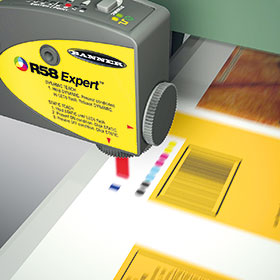

Registration marks identify packaging material and are used for position control and to coordinate the separation and cutting of webs of packaging material. The webs are processed at high speeds and product changeovers can be frequent. The size and location of a registration mark as well as the colour, sheen and translucence of the material can significantly affect mark detection. Keep reading to learn more.
Q: What is the difference between a true colour sensor and a colour registration mark sensor?
True colour sensors can be taught to detect minute colour differences (for example, it can tell dark blue from black), while colour mark sensors detect a greyscale change in colour. True colour sensors, like Banner’s QC50, reflect light off a target using a white LED and red, green and blue filter elements. A colour value is then assigned to the light returning to the sensor based on the amount of light reflecting off the target. With colour mark sensors, the sensor uses just an LED and no filters. The sensor distinguishes the target colour based on how it contrasts with the background colour.
Q: Isn’t it better to use a true colour sensor rather than a colour mark sensor?
Not always. A large number of colour sensing applications can be done quite effectively by detecting a greyscale change in the colour mark. In these instances, we recommend using a colour mark sensor like the R58E, especially in high-speed applications. A true colour sensor is required when sorting out targets that differ only in colour; for example, when you need to distinguish between light blue and dark blue. However, when distinguishing a registration mark on a constant background, a colour mark sensor is your best choice.
Q: What’s the difference between a colour mark sensor and a registration mark sensor?
There is no difference; these terms are synonymous.
Q: What does 16 greyscale contrast levels specification mean?
One way to spec a colour mark sensor is to understand how many levels of greyscale it can detect. The finer the sensor’s resolution, the more levels can be detected. A commercial greyscale printer’s chart is divided into 20 segments ranging from black to white, and the shades of gray between. Many sensors are able to detect the first 16 segments starting at white.
Q: Does Banner’s R58E have a spec for greyscale contrast levels?
The R58E can easily meet the spec for 16 levels of greyscale. Because of the combination of RGB LEDs, the R58E’s resolution capability far exceeds greyscale charts. The R58E’s capability for subtle contrast changes far surpasses the specification for 16 levels of greyscale.
Q: Is it true that processing time for the colour mark sensor affects speed?
Speed is more of an issue for a true colour sensor rather than a colour mark sensor. The R58E from Banner can perform 10 000 actuations per second.
Q: Why does Banner’s R58E colour mark sensor use the red, green, and blue combination of LED colours?
The R58E uses this combination so that it can reliably sense virtually any registration mark/background combination. The RGB (red, green, and blue) combination can be combined to create almost any colour. Your computer monitor, for example, which is capable of millions of colours, uses a RGB technology. The R58E, using these three colours, is able to determine the colour of the registration mark and the colour of the background. The sensor will then use the LED that provides the best contrast between the registration mark and the background.
Q: How do I pick the right LED colour for my application?
With the R58E, you do not need to choose an LED colour. The R58E selects the proper LED colour automatically during the initial TEACH function. However, when using a mono- chromatic colour mark sensor, resources such as colour selection charts are used to select
the proper LED colour.
Q: How do I switch between the different LED colours?
You don’t need to manually switch LEDs. The R58E will automatically select LED colours during the TEACH function.
Q: Can I choose the LED colours in the R58E?
No. The R58E comes with only the possibility of three LED colours: red, green and blue.
Q: Does having three LED colours affect the sensor’s response time?
No. After the initial TEACH process, the R58E’s response time is the same as comparable registration mark sensors. The R58E has a 50 microsecond response time, which allows 15 microsecond repeatability.
Q: How do I sense a registration mark on clear material?
Clear materials don’t reflect light very well, so when sensing a registration mark on a clear material, position a reflective surface directly behind the clear material to return light to the sensor. The registration mark will block the light from reaching the reflective surface and will be detected by the sensor. To avoid the shine from clear materials, you might consider mounting your sensor at a 15° skew angle.
Q: How can I maximise sensing in my high-sensitivity applications with the R58E?
Use the dynamic TEACH function to teach the sensor a series of conditions on the fly. The R58E takes multiple samples of a registration mark against its background and is able to automatically set the sensitivity at the optimum level.
For more information contact Brandon Topham, RET Automation, +27 (0)11 453 2468, [email protected], www.retautomation.com
| Tel: | +27 11 453 2468 |
| Email: | [email protected] |
| www: | www.turckbanner.co.za |
| Articles: | More information and articles about Turck Banner Southern Africa |

© Technews Publishing (Pty) Ltd | All Rights Reserved